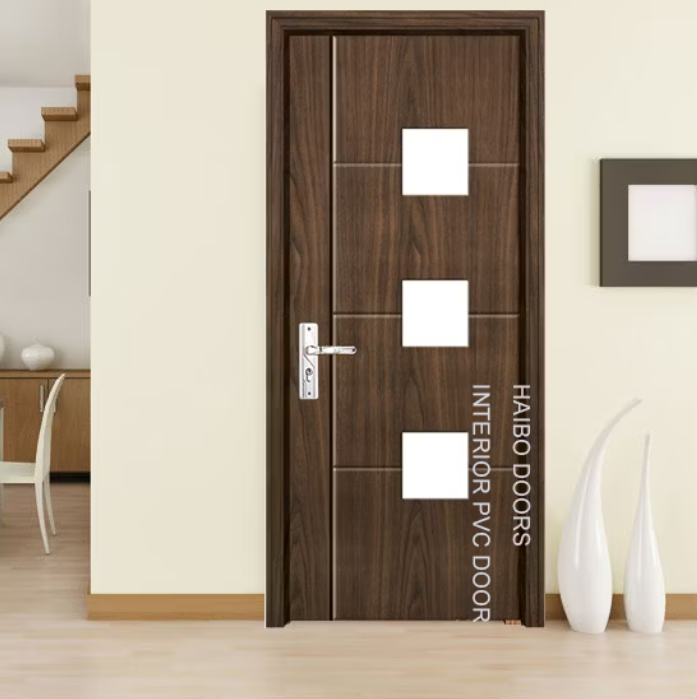In recent years, PVC interior doors have become the preferred choice for homeowners, architects, and interior designers. They are now not only an affordable option but also recognized for their practicality, versatility, and aesthetics. Whether you're renovating a bathroom, designing a modern kitchen, or furnishing a hotel room, PVC doors offer numerous benefits that make them a wise long-term investment.
1. Moisture Resistance: The Ideal Choice for Humid Spaces
Moisture resistance is one of the defining characteristics of PVC doors. Traditional wooden doors tend to swell, warp, or rot over time when exposed to high humidity or direct water contact. This is particularly problematic in areas like bathrooms, laundry rooms, and kitchens—spaces that experience regular moisture, steam, and temperature fluctuations.
PVC doors, by contrast, are non-porous and do not absorb water. Their surface acts as a barrier against humidity, making them resistant to mold, mildew, and decay. This feature not only ensures the longevity of the door but also reduces the chances of structural damage to door frames and adjacent walls.
Practical Implication:
For coastal homes or apartments with poor ventilation, installing PVC doors in all moisture-prone areas can significantly reduce maintenance costs and the need for frequent replacements.
2. Low Maintenance: Effortless Upkeep for Busy Households
Another major advantage of PVC interior doors is their incredibly low maintenance requirement. While wooden doors require periodic polishing, repainting, or sealing to maintain their look and protect them from moisture and pests, PVC doors are much more forgiving.
Key benefits of low maintenance:
-
No repainting or varnishing needed: PVC retains its original color and texture for years.
-
Scratch and stain resistance: Everyday scuffs and smudges from pets, children, or shoes can be wiped off with a damp cloth.
-
No pest damage: Unlike wood, PVC is impervious to termite and borer infestations.
For households with children or pets, or in commercial environments like hotels or clinics where doors endure frequent use, PVC proves to be a practical and hygienic option.
Daily Life Example:
Imagine a family home with three children. Hallway doors covered in fingerprints, marker lines, or smudges can be easily cleaned without the need for special treatment—saving time and stress for busy parents.
3. Durability: A Door That Stands the Test of Time
Durability is often a concern when selecting any construction material, especially for high-use elements like interior doors. PVC interior doors excel in this regard. Their structure is resistant to warping, cracking, and chipping—common problems found in poorly finished wood or low-quality fiberboard alternatives.
PVC doors are also lightweight yet structurally strong, making them easy to open and close without compromising on durability. Thanks to advances in manufacturing techniques, many PVC doors are now reinforced with additional core materials to enhance strength and insulation.
Material Performance Overview
| Feature | PVC Doors | Wooden Doors | Metal Doors |
|---|---|---|---|
| Moisture Resistance | Excellent | Poor | Average |
| Termite Proof | Yes | No | Yes |
| Maintenance Required | Low | High | Moderate |
| Longevity | 15–25 years | 10–15 years | 15–20 years |
| Weight | Light | Medium to Heavy | Heavy |
| Paint/Varnish Needed | No | Yes | Sometimes |
While wooden doors may appeal to those seeking a traditional feel, their tendency to age quickly in unfavorable environments makes PVC a more reliable option for durability-focused buyers.
4. Cost-Effective: Quality Without Breaking the Bank
Affordability plays a key role in decision-making, especially for bulk housing projects, rental properties, or budget-sensitive renovations. PVC doors are significantly less expensive than natural wood or custom-engineered metal doors, both in upfront costs and long-term maintenance.
Where savings come from:
-
Lower material costs: PVC production is efficient and scalable.
-
Reduced maintenance: No costly treatments, painting, or pest control required.
-
Installation ease: Lightweight nature means less labor effort and time during setup.
-
Longer lifespan: Replacements and repairs are less frequent.
While some may initially hesitate due to perceived quality differences, modern PVC door designs have closed the aesthetic gap with high-end alternatives, making them a competitive option for both residential and commercial interiors.
Tip:
For developers outfitting apartment buildings or hotels, PVC doors reduce total project costs significantly while maintaining quality and appearance.
5. Variety of Styles: From Minimalist to Traditional Aesthetics
Aesthetics remain a top concern for interior designers and homeowners. Fortunately, PVC doors today come in a wide array of styles, colors, and textures. They can mimic the grain of real wood or offer clean, contemporary finishes in matte, gloss, or textured patterns.
Some popular design styles include:
-
Wood-look finishes: Oak, teak, cherry, and walnut prints replicate the natural grain of traditional wood.
-
Matte pastels and neutrals: Ideal for Scandinavian or minimalist interiors.
-
High-gloss panels: Sleek options for contemporary apartments or luxury spaces.
-
Textured patterns: Subtle grooves, paneling effects, and embossed designs for added character.

Practical Applications of PVC Interior Doors
PVC doors can be used throughout a home or commercial building. Here’s how they adapt to different spaces:
| Room/Area | Why PVC Works Well There |
|---|---|
| Bathroom | Resists humidity and splashes; easy to sanitize |
| Kitchen | Won’t warp from heat or steam; low cleaning effort |
| Laundry Room | Durable against dampness and detergent spills |
| Bedroom | Available in quiet, calming designs; light yet sturdy |
| Closet Doors | Lightweight and easy to match with built-ins |
| Office | Modern styles available; easy maintenance in workspaces |
Additional Benefits That Add Value
Beyond the five main advantages, PVC interior doors offer several auxiliary benefits worth noting:
-
Eco-friendliness: Many manufacturers now use recyclable or low-VOC PVC materials.
-
Thermal and sound insulation: Some doors feature multi-layered cores for better privacy and energy efficiency.
-
Fire resistance: Fire-rated variants are available for safety compliance.
-
Easy integration with frames and hardware: Compatibility with standard hinges, locks, and handles simplifies renovation.
These add-ons make PVC doors not just convenient—but also safe, modern, and environmentally responsible.
Practical Luxury with Haibo Expertise
For those seeking a balance between affordability, design flexibility and long-term performance, PVC interior doors offer a complete solution. From moisture resistance to ease of maintenance, the benefits of PVC interior doors are sure to meet the ever-changing needs of modern living.
Zhejiang Haibo Door Co., Ltd. has invested in developing advanced PVC door solutions that combine style, function, and reliability. Our design team offers a wide range of textures and finishes, and our production facilities ensure high standards of durability and consistency. Whether you are renovating a single-family home or a large commercial project, Haibo provides the quality and customization you need—backed by industry experience and design innovation.

 English
English русский
русский Français
Français Español
Español bahasa Indonesia
bahasa Indonesia عربى
عربى



